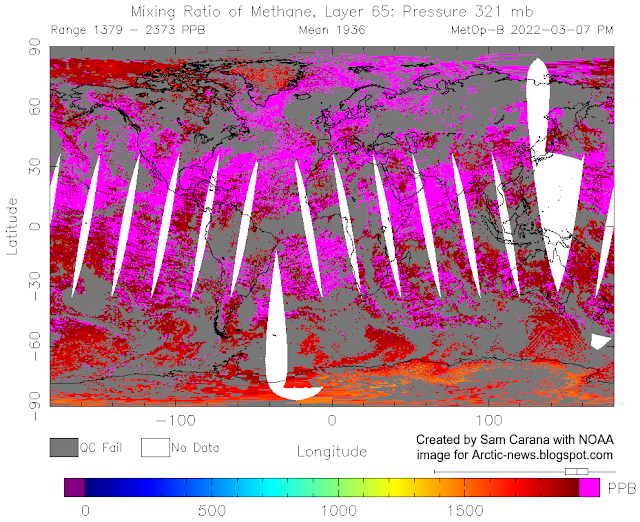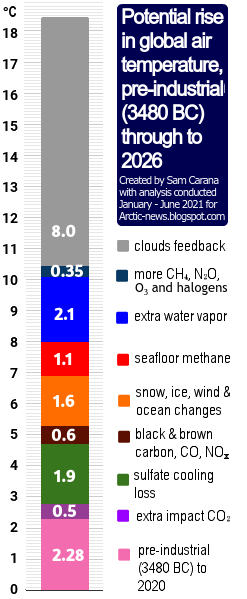NOAA's globally averaged marine surface monthly mean methane reading for November 2021 of 1909.3 parts per billion (ppb) is 17.6 ppb higher than the reading for November 2020. By comparison, NOAA's annual global mean methane increase of 15.57 ppb for 2020 was at the time the highest on record.
Keep in mind that this 1909.3 ppb reading is for November 2021; it now is March 2022. Furthermore, NOAA's data are for marine surface measurements; more methane tends to accumulate at higher altitudes.
Carbon dioxide
Carbon dioxide levels are currently very high over the Arctic, as illustrated by the image below that shows carbon dioxide levels approaching 430 parts per million (ppm) recently at Barrow, Alaska.
Clouds tipping point
 |
| [ from earlier post ] |
The MetOp-B satellite recorded a mean methane level of 1958 ppb on October 25, 2021 am at 295 mb. When using a 1-year GWP of 200, this translates into 391.6 ppm CO₂e. Together with a global mean CO₂ level of 420 ppm, that's 811.6 ppm CO₂e, i.e. only 388.4 ppm CO₂e away from the 1200 ppm CO₂e clouds tipping point.
The image on the right shows a trend based pointing at a methane level of almost 4000 ppb by end 2026, from an earlier post.
Alternatively, an additional 5 Gt of methane from abrupt release from the seafloor could raise the global mean methane concentration by about 2000 ppb, and even earlier than 2026.
At a 1-year GWP of 200, an extra 2000 ppb would translate into an extra 400 ppm CO₂e, thus pushing the joint impact of just two greenhouse gases (carbon dioxide and methane) above the 1200 ppm CO₂e clouds tipping point and raising the global temperature by 8°C due to the clouds feedback alone, i.e. on top of the additional rise caused by other warming elements, as further discussed below.
Alternatively, an additional 5 Gt of methane from abrupt release from the seafloor could raise the global mean methane concentration by about 2000 ppb, and even earlier than 2026.
At a 1-year GWP of 200, an extra 2000 ppb would translate into an extra 400 ppm CO₂e, thus pushing the joint impact of just two greenhouse gases (carbon dioxide and methane) above the 1200 ppm CO₂e clouds tipping point and raising the global temperature by 8°C due to the clouds feedback alone, i.e. on top of the additional rise caused by other warming elements, as further discussed below.
Seafloor methane eruptions could trigger a huge temperature rise
Warnings about the potential for seafloor methane releases have been given repeatedly, such as in this 2017 analysis, in this 2019 analysis (image below) and in a recent analysis (2022). Researchers in 2019 found amounts of methane in the air over the East Siberian Sea up to nine times the global average.
A 2021 analysis indicates that massive methane seepage from the seafloor of the Arctic Ocean occurred during ice sheet wastage over the last and penultimate deglaciation periods (i.e. the Holocene, ~20-15 ka, respectively the Eemian, ~140-130 ka).
At the time, seafloor methane entering the atmosphere could be accommodated without resulting in huge temperature rises, because such releases were spread out over relatively long periods, while the level of methane in the atmosphere at the time was relatively low and since the lifetime of methane is limited to a decade or so.
Today, circumstances are much more dire in many respects. While high heat peaks may have occurred locally during the last and penultimate deglaciation, today's global mean temperature is higher, as James Hansen et al., confirmed in a 2017 analysis. Furthermore, a 2012 analysis indicates that oceanic heat transport to the Arctic today is higher.
Greenhouse gas levels are very high at the moment and their rise is accelerating. As a result of the rapidity of today's rise, new seafloor methane eruptions can occur while previous methane releases haven't yet been broken down in the atmosphere.
Greenhouse gas levels are very high at the moment and their rise is accelerating. As a result of the rapidity of today's rise, new seafloor methane eruptions can occur while previous methane releases haven't yet been broken down in the atmosphere.
Seafloor methane eruptions can thus trigger a huge temperature rise, as illustrated by the image on the right, from the extinction page.
Conclusions
The situation is dire and calls for the most comprehensive and effective action, as described at the Climate Plan.
Links
Links
• NOAA - globally averaged marine surface monthly mean methane data
https://gml.noaa.gov/webdata/ccgg/trends/ch4/ch4_mm_gl.txt
• NOAA - globally averaged marine surface annual mean methane growth rates
https://gml.noaa.gov/webdata/ccgg/trends/ch4/ch4_gr_gl.txt
• NOAA - Infrared Atmospheric Sounding Interferometer (IASI) Sounding Products (MetOp-B)
https://www.ospo.noaa.gov/Products/atmosphere/soundings/iasi
• NOAA - Trends in Atmospheric Carbon Dioxide
https://gml.noaa.gov/ccgg/trends/gl_trend.html
• NOAA - Carbon Cycle Gases, Barrow Atmospheric Baseline Observatory, United States
https://gml.noaa.gov/dv/iadv/graph.php?code=BRW
• NOAA - Trends in Atmospheric Carbon Dioxide, Mauna Loa, Hawaii
https://gml.noaa.gov/ccgg/trends/graph.html
• Clouds feedback
https://arctic-news.blogspot.com/p/clouds-feedback.html
• Human Extinction by 2022?
https://arctic-news.blogspot.com/2021/11/human-extinction-by-2022.html
• Terrifying Arctic methane levels
https://arctic-news.blogspot.com/2021/12/terrifying-arctic-methane-levels.html
• Terrifying Arctic methane levels continue
https://arctic-news.blogspot.com/2022/01/terrifying-arctic-greenhouse-gas-levels-continue.html
• Current rates and mechanisms of subsea permafrost degradation in the East Siberian Arctic Shelf - by Nataia Shakhova et al. (2017)
https://www.nature.com/articles/ncomms15872
• Understanding the Permafrost–Hydrate System and Associated Methane Releases in the East Siberian Arctic Shelf - by Nataia Shakhova et al. (2019)
https://www.mdpi.com/2076-3263/9/6/251
• CNN - Russian scientists say they've found the highest-ever 'flares' of methane in Arctic waters
https://edition.cnn.com/2019/10/12/us/arctic-methane-gas-flare-trnd/index.html
• In-situ temperatures and thermal properties of the East Siberian Arctic shelf sediments: Key input for understanding the dynamics of subsea permafrost - by Evgeny Chuvilin et al. (2022)
https://www.sciencedirect.com/science/article/abs/pii/S0264817222000289
• When Will We Die?
https://arctic-news.blogspot.com/2019/06/when-will-we-die.html
• In-situ temperatures and thermal properties of the East Siberian Arctic shelf sediments: Key input for understanding the dynamics of subsea permafrost - by Evgeny Chuvilin et al. (2022)
https://www.sciencedirect.com/science/article/abs/pii/S0264817222000289
• When Will We Die?
https://arctic-news.blogspot.com/2019/06/when-will-we-die.html
• Arctic methane release due to melting ice is likely to happen again
https://www.geosociety.org/GSA/News/pr/2021/21-15.aspx
• Ice-sheet melt drove methane emissions in the Arctic during the last two interglacials - by Pierre-Antoine Dessandier et al. (2021)
• Ice-sheet melt drove methane emissions in the Arctic during the last two interglacials - by Pierre-Antoine Dessandier et al. (2021)
https://pubs.geoscienceworld.org/gsa/geology/article-abstract/49/7/799/595627/Ice-sheet-melt-drove-methane-emissions-in-the
• Contrasting ocean changes between the subpolar and polar North Atlantic during the past 135 ka - by Henning Bauch et al. (2012)
https://agupubs.onlinelibrary.wiley.com/doi/full/10.1029/2012GL051800
• Contrasting ocean changes between the subpolar and polar North Atlantic during the past 135 ka - by Henning Bauch et al. (2012)
https://agupubs.onlinelibrary.wiley.com/doi/full/10.1029/2012GL051800
• Extinction
• Climate Plan




